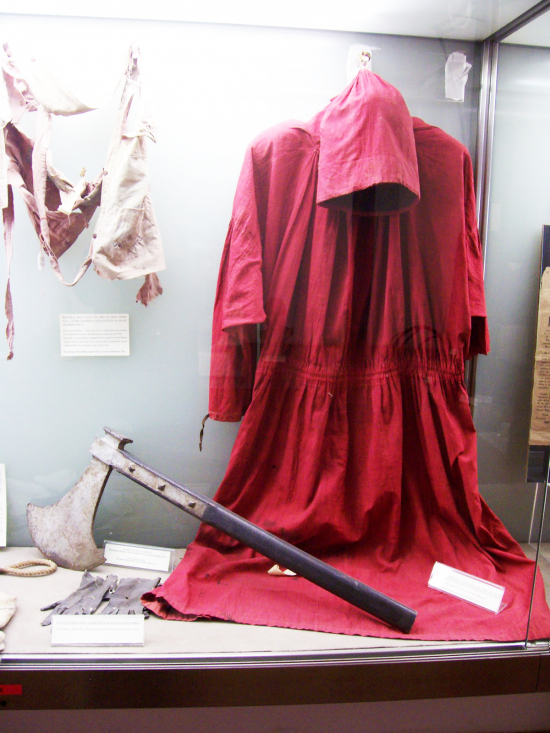Every town has its own local celebrities. Rome had Mastro Titta.
Giovanni Battista Bugatti was born around 1779 and worked as a painter of umbrellas. He lived in Borgo Sant’Angelo, on the other side of the Tiber and for his personal security he was obliged to remain there for ever: if he had shown his face in the city streets, he would have certainly been torn apart. So he used to keep calm, safe in his compulsory residence in vicolo del Campanile, until his services were required. Then, after taking off the lowly clothes of the umbrella mender, like a modern superhero Bugatti put on a scarlet cloak and changed into his extraordinary and dreaded alter ego: Mastro Titta. He went to church to confession, on bended knees, he communicated and then with great pomp and ceremony he resolved to cross the river. “Mastro Titta crosses the river!” people screamed all over Rome: the show was about to begin.
A real living legend, Mastro Titta never made a mistake. Either with the mallet, the hatchet or the ropes, he worked with exquisite dexterity: he brought the condemned to their final stage, under the eyes of the people crowded in Piazza del Popolo, and sometimes offered them a pinch of tobacco as a last earthy consolation. Then, according to the sentence pronounced by the Pope, the papal executioner set to work. He hanged, strangled, beheaded, burnt. The blow with the mallet and the quartering required strength and precision: Mastro Titta smashed the culprit’s head with a well arranged blow with the mallet, then cut the body into pieces and fixed them to the corners of the scaffold while, among the onlookers, parents obliged their children to pay attention to the scene. They had to learn how people end up when they go astray.
During his 68 year long career, Mastro Titta carried out 516 executions (giustizie), all performed in an exemplary manner by a “model executioner, and an artist really worth the stage on which he was called to act”, according to the definition of the Florentine writer Alessandro Ademollo. Even when the very latest in technology arrived from Napoleon’s France – the “new structure to cut heads” so much talked about, namely the guillotine – Mastro Titta proved to be able to handle it perfectly. In scarcely four years, from 1810 to 1813, 56 heads fell into the basket. They were all meticulously noted down by Bugatti in his notebook, where he used to record every assignment since the beginning of his career, writing down dates, names, crimes, the reward he received and the bonus he obtained every now and then, when the execution had been so astonishing to arouse the admiration of the Pope himself or the bishops.
The 1st November 1864, “er Boja de Roma” retired from the stage at last, with a guaranteed monthly pension of 30 écus as a reward for the many years of unblemished service. He was so famous that after him every executioner was invariably called Mastro Titta. He died in 1869, at the venerable age of ninety.
But his figure permanently entered the town’s mythology, from literature to folklore, from Belli’s sonnets to nursery rhymes for children: Saw, saw, Mastro Titta / a loaf and a sausage / one for me one for you / one for mum and there are three.
Lord Byron and Charles Dickens wrote about him, as they had witnessed a few of his executions, and Roman folklore celebrated him in countless ways, up to musical comedies with Aldo Fabrizi and movies by Luigi Magni.
The famous scarlet frock of Mastro Titta, together with his hatchet and a few guillotines, can still be admired at the Criminological Museum in Rome.

